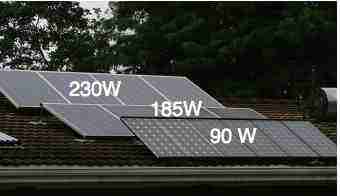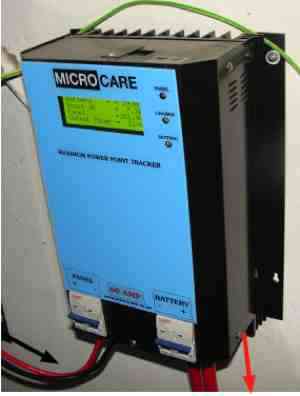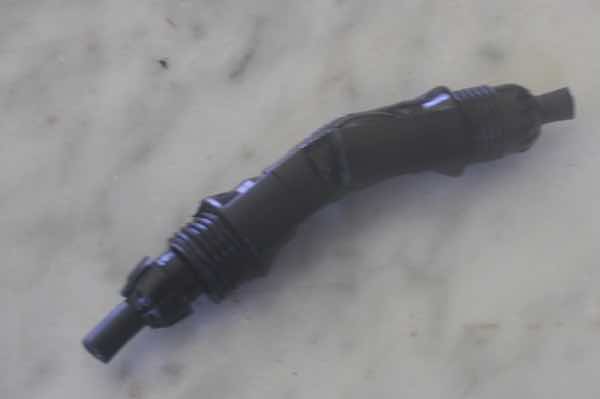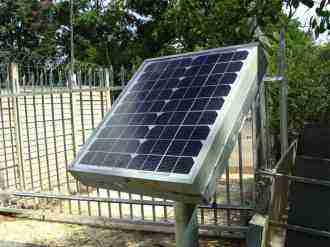- Bernard Preston homepage
- Solar geek
- Solar System Facts
Solar System Facts
Solar system facts has nothing to do with the movement of the planets in their orbits around the sun; rather it is all about the utilizable energy arriving at the Earth's surface from our golden-friend, the Helios.
This page was last updated by Bernard Preston on 24th May, 2021.

The International Renewable Energy Agency states the cost of solar power dropped an amazing 73% from 2010 to 2017, and that it will continue to fall; further that PV panels can now produce electricity more cheaply than coal, gas or nuclear power stations.
How many panels can you put in one array? Try to avoid what you see above; three unbalanced arrays of panels is not ideal, but I have made it to work using one-way diodes that protect the weaker ones. Rather, start big with the largest PVs you can get because they are cheaper, and keep to the same size.
Actually some say that those around 280W are more efficient, but I cannot comment.
"We do not have to pay for wind and sun - the feedstock will come free."
- Michael Power
Two principles are important to grasp before building your solar generator.
- How many amps can your regulator handle?
- How many volts will it take?
Solar System Facts
Solar system facts answers how many panels can you build in one array to raise the voltage as much as possible.
Solar power energy can be readily collected in your home or business; it is not rocket science but a considerable amount of planning and decision making is necessary.
And some understanding of electricity, if you want to build a solar powered generator yourself.
What are the energy losses?
Losses in your system can ruin the party if you do not understand one
important fact; the heat generated in the copper cables is formulated by
Joule's first law. It is energy completely wasted and should be minimised.
If you do not have a basic physics background, then perhaps some of these solar system facts are Greek to you, but try and get this; the heat loss in your cables is dependent on the
- current squared
- resistance of the wire
So, we want to keep the current as low as possible, and the length of wire as thick and short as possible.
Resistive loss
Another way of looking at these solar system facts, is the perspective of the voltage. Let us say you are using a 230 watt solar photovoltaic or PV panel. That power has to be carried down the cable to your regulator, known as a MPPT; more about that elsewhere.
The standard formula is Power = VI or volts x amps.
We could then have
- 230 watts = 12 volts x ~20 amps
- 230 watts = 24 volts x ~10 amps
- 230 watts = 48 volts x ~ 5 amps.
Simply raising the voltage from 12V to 48V drops the current by a factor of 4 from 20A to 5A.
But did you get the important part? The resistive losses in your cabling, proportional to the current squared remember, then drops by a factor of 16 as you increase the voltage.
- Bernard Preston homepage
- Solar geek
- Solar System Facts
So, we want to raise the voltage in the whole system as much as possible and this can be done by increasing the number of panels in series. But, is there a limit? Could you have ten big 230W panels in series.
The answer is yes, there is a limit and secondly, no, you cannot have ten panels in series. It is all determined by the capacity rating of your MPPT.
The Regulator = MPPT

To protect your battery from overcharging from the solar panels, you need a regulator; in your car it's simply called a regulator, but in a solar powered generator it's a more fancy device called an MPPT.
MPPTs come in different sizes, capable of processing more and more current, but from my supplier, Microcare, they all will allow for 150 volts.
You can buy a whole range, but my recommendation is you go for a 60A MPPT. After that the price goes up quite steeply and for reasons I won't mention here, it makes more sense to have two 60 amp MPPTs rather one 100 amp MPPT, if you want to go bigger than 60A. More about that later.
Okay, so we are talking about 150 volt and 60 amp maximum on a Microcare regulator. These solar system facts are vitally important if you are going to save a bundle and build your own generator.
Batteries, more solar system facts.
There are two reasons you might want to use batteries.
- You want to go off the grid and you need power at night.
- Your utility supply is irregular and you get surges and brownouts that are damaging your computers and motors.
In a country with clean, reliable electricity rather choose a grid tied system that has no batteries.
There are two parts of the circuit. That running from the panels to the MPPT, marked with the black arrow above, and we have determined that the maximum allowed voltage is 150 volts according to the manufacturer.
But there's another part of the circuit. That between the batteries and the inverter, marked with the red arrow in the diagram above. Here the currents start to get really high, and the amps squared losses even more so.
So, more batteries, and short, thick copper cables.
You can have 12V from 1 battery, 24V from 2 batteries or 48V from 4 batteries.
My advice is that you bite the bullet and go for a 48 volt system. Yes, it costs more, and you will have to have four of those expensive twelve volt batteries, but your whole solar generator will be much more efficient.
Again, high voltage, lower current and less losses; you won't be sorry.
Incidentally, deep cycle lead cell batteries are not good. They will last only a few years. Bite that bullet and purchase the best quality you can; then they'll survive for ages.
Here's a thought, though. Can you get the battery out of a wrecked electric car?
Many people are now going for a larger number of 2V instead of twelve volt batteries.
So, how many panels can you put in series? What are the solar system facts? Let us talk about PVs. You will need to check out the manufacturer's specifications, but I can tell you that mine put out 36.8V each.
You have to use the Voc figure; open circuit voltage.
When the panels are in open circuit and not drawing current, the voltage rises. This will happen when the batteries are full and your inverter is not drawing any amps; for example if you were on holiday.
So the voltage on my panels is 29.9 volts when current is being drawn, but 36.8V in open circuit at 45 degrees celsius.
- 1 panel 36.8 volts
- 2 panels 73.6 volts
- 3 panels 110.4 volts
- 4 panels 147.2 volts
Four panels looks like it's getting dangerously close to the 150 volts maximum that the regulator can cope with; but there are two more solar system facts to look at.
- There is a volts drop factor in the cabling. It is best you contact your supplier and find out what the volts drop per meter of cable is. It will probably be of the order of 10 to 20 volts depending on how long, and how thick your cables are and that gets us safely away from 150 volts.
- Voc is dependent on the
temperature. It drops making the panels less efficient when it's very
hot. On the other hand, when the temperature drops, Voc rises, and this
could take your solar system facts back into the danger zone of 150 volts maximum.
My 230 volt panels have a temperature coefficient of -0.34% per degree C.
So, at the frost point, the rise in Voc for four panels in series would be
0.34/100 x 147.2 V x 45 C = 22.5 volts.
So, in summary the voltage of your four panels at zero degrees would be 147.2 volts - volts drop in cabling + 22.5 volts.
In open circuit, with batteries full, there is no volts drop as no current would be drawn from the panels, so the voltage would rise to around 170 volts. That's way over the maximum allowed; and higher still if you live in very cold temperatures.
So, it would be safer to use three 235 watt panels in series.
In short, do your homework and get advice about the solar system factrs from your supplier.
Newsletter
Our newsletter is entitled "create a cyan zone" at your home, preserving both yourself and Mother Earth for future generations; and the family too, of course. We promise not to spam you with daily emails promoting various products. You may get an occasional nudge to buy one of my books.
Here are the back issues.
- Lifestyle and ideal body weight
- What are ultra-processed foods?
- Investing in long-term health
- Diseases from plastic exposure
- Intensive lifestyle management for obesity has limited value
- A world largely devoid of Parkinson's Disease
- The impact of friendly bacteria in the tum on the prevention of cancer
- There's a hole in the bucket
- Everyone is talking about weight loss drugs
- Pull the sweet tooth
- If you suffer from heartburn plant a susu
- Refined maize meal and stunting
- Should agriculture and industry get priority for water and electricity?
- Nature is calling
- Mill your own flour
- Bake your own sourdough bread
- Microplastics from our water
- Alternative types of water storage
- Wear your clothes out
- Comfort foods
- Create a bee-friendly environment
- Go to bed slightly hungry
- Keep bees
- Blue zone folk are religious
- Reduce plastic waste
- Family is important
- What can go in compost?
- Grow broad beans for longevity
- Harvest and store sunshine
- Blue zone exercise
- Harvest and store your rainwater
- Create a cyan zone at your home
Is it worth risking it and having four panels? No, it is not, especially if you are just starting out. I am semiretired and able to spend the time tinkering, and watching those volts and amps. In fact, that is what has made this such an exciting project.
In my own particular situation, my maximum at the regulator on a hot day is 127 volts in open circuit. Add to that 20 to 25V in midwinter when the temperature falls below freezing, and it will take me dangerously close to 150 at which point the MPPT will close down.
It won't damage it, but the MPPT simply will not work.
Normally speaking, on a cold and frosty morning the batteries will not be full, and so the panels will not be in open circuit. But should I go on holiday in midwinter, I may have to switch off the MPPT.
You can be sure that with winter approaching I will be watching the meter on the MPPT very carefully to see what the voltages are in the early morning when temperatures will be below freezing.
Unsure? Put up three panels, allowing for a fourth if it seems you won't be having problems of exceeding 150V.
So, I will be running my solar generator near the maximum allowed voltage for lower currents and fewer losses in the cabling.

If the current is too high, then the connectors overheat and melt, and you have all the potential for a fire.
Can I put two arrays of panels in parallel?
So you cannot increase above three, maybe four, panels in series in one array. How then can you increase the capture of more solar power energy?
The answer is yes, you can add more arrays but we'll develop that theme on another page. Remember you can't exceed the rating of your MPPT; 60A in my case.
My advice is to start big because you will want to add more arrays of panels as you discover that Mr Golden Sun is offering more free gifts of photons for you to use. Adding more panels is easy. Exchanging your inverter and MPPT for larger ones is an expensive, unnecessary chore.
And buy quality equipment. Cheapos do pack up, especially if you buy a small inverters and MPPT, and then strain them to the limit on a rainy day.
The highs and lows of photovoltaic system calculations site will help you with a lot more solar system facts. It is not yet an https high security site, so look for this at ecmweb.com
Danger @ Solar system facts
Please remember you must never, ever disconnect your panels from each other when they are generating current. These are high voltage direct currents and you will get an arc that may be difficult to extinguish. Always first drop the MPPT panel breaker so that it cannot draw current when working with your arrays of PVs.
Alternatively cover one of the panels with blankets if you are up on the roof.
Residential solar panels
There are several other projects where you could use solar power energy. For example, you do have a swimming pool? Heating the water and running the pump is an example. That could either be done using a solar pump or driving the conventional motor using your solar generator; that's what I do. Or using residential solar panels to power your electric gate?

Power energy
So, the solar power energy is free. Collecting and using it in its direct current form is cheap; AC distribution costs a lot more, but is obviously more useful in the home. You can't run your lawnmower on DC.
I hope these solar system facts are proving useful.
One might think of energy and power, like distance and speed; time comes into the equation, or the rate at which it can be done.
Distance is measured in "metres".
Speed = distance / time. Metres per second. It gives us a measure of how quickly a car is covering a certain distance. The unit is metres per second.
Energy is measured in "joules".
Power = energy / time. Joules per second. It gives us a measure of how quickly energy is being used. The unit is Joules per second, or watts.
So, the incandescent globe you're using right now has a rating of 100W. It's consuming 100 joules per second. Dispose of it; a 6W LED globe delivers much the same light. It consumes only 6 joules per second. Buy LED light bulbs.
Useful links
Bernard Preston
Aside: What makes for a rich, full life? I, Bernard Preston, decided a long time ago that it was a lot more fulfilling having fun myself than watching others have fun on television. Yes, grasping these solar system facts, and putting them into practice takes time and energy. But gosh, this has been a very satisfying project.
If you have found this a rewarding page, you can reward me by buying one of my Bernard Preston books of anecdotes from a DC's coalface. It was whilst in Holland for seven years that I first grasped the enthusiasm of the Dutch for the environment.
These books are cheap on your Kindle, tablet or smartphone. Instantly downloadable and great bedside readings. They have been described by a fan as 'healthful and funny stories from the life and work of a DC.' You WILL enjoy them, or your money back! Dinkum, I can say that because no one ever has, nor will you. Just as important, you will read them to the end.
Alas they have nothing to do with solar system facts; they are about better health facts. Is it your desire to reach a happy and healthy eighty and sit under the trees you once planted watching the grandchildren growing up?
Today, it is a toss up; I have a weakness for sport on television and South Africa and England are squaring up on the cricket field in the World Series. Or shall I go soaring with the eagles to cloud base in my glider? Or prepare another bed in the winter garden? I need more space for a how to grow peas demonstration; they also can store the sun's energy.
Mm, I think the weather looks perfect for gliding and I can watch the match highlights later this evening. The Garden Cathedral will keep until tomorrow.
Have a good day tinkering! Take a walk.
Did you find this page interesting? How about forwarding it to a friendly book or food junkie? Better still, a social media tick would help.
- Bernard Preston homepage
- Solar geek
- Solar System Facts
Address:
56 Groenekloof Rd,
Hilton, KZN
South Africa
Website:
https://www.bernard-preston.com